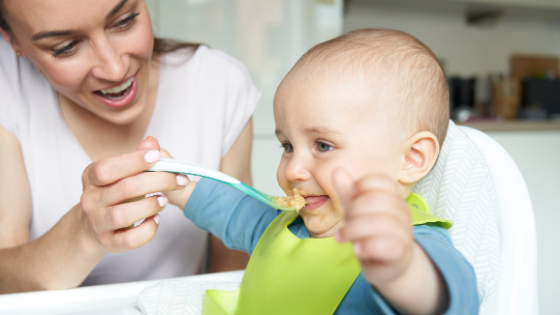Contents
When and How to Wean Your Baby
Guest Post by Rachel Burns
So the young one is finally ready for solid foods, great news. This is both an exciting and terrifying moment for the parents because they are unsure what makes the cut for the right baby food. This phase is quite experimental, and it should be handled with caution.
Here are a few tips and hacks to guide you through this new parenting phase.
Get the Timing Right
As a parent, how do you know that your baby is ready for solid foods? Well, different babies will have their own timelines. Still, it’s highly advisable to stick to breast milk and baby formula until the child is six months old.
In all honesty, this growth stage will test your patience to an extreme limit, especially if your baby proves to be a picky eater.
During the weaning process, your child is experiencing different food textures and flavours, so it might take several attempts before accepting them or showing a favourable response.
Naturally, you’re excited about your child trying out new foods. Still, you should remember that their digestive tracts are not fully equipped to handle solid food just yet. Which is why it’s important to try and keep your baby food recipes to the bare minimum, and introduce new components slowly.
During the first weeks or so, your child will feed on a lot less than you presume. In fact, some babies will eat as little as two tablespoons a day, so don’t try to force-feed them.
Introducing Your Baby to Food
Naturally, a lot of parents are inclined to making organic baby food when weaning. This is not a bad idea, but you should be careful with the foods you are using. Now, not everyone can offer homemade baby food, so they can settle for infant cereal instead. If possible, go for the best baby cereal brand you can afford.
It’s important to keep the baby food diet simple to aid in digestion, and it also helps with how they will respond to it. A great first option can be pureed fruits such as avocados or bananas.
Alternatively, you can use baby food pouches or pre-prepped meals such as yumi baby food to feed your young one. These can come in handy if you’re the busy parent or can’t decide on the best baby food.
How can You Tell When it’s the Right Time?
Besides the clinical chart, you can tell your baby is ready to try out solid foods using these tell-tale signs as they get older.
At about 4 months, their tongue-thrust reflex begins to fade. This reflex prevents choking and gagging during their suckling age.
At this same age, their digestive tract begins to produce enzymes that can break down simple foods.
If they can support their head when held upright, their neck muscles are strong to prevent choking.
They will start reaching out for items associated with mealtimes, such as the bottle or your plate.
The Concern about Allergies
So you’re worried about allergies and breakouts; good call! It can be quite frustrating to feed your baby without knowing whether they’ll have a reaction.
However, if there is an allergic family history on either side of the parents, consult with a paediatrician beforehand.
In addition, some studies suggest that delaying typically allergenic food increases the chances of them having an allergic reaction.
When introducing foods you consider allergenic, do it in the morning hours, and do it at home. Also, wait for at least five days before introducing any new foods to their diet. This spacing will allow you to gauge for any unwanted reactions.
How Do You Know Your Baby Is Having An Allergic Reaction?
As a parent, it shouldn’t be hard to recognize a negative reaction to food. Typically, a food allergy will occur a few minutes after ingestion to several hours later.
Some common signs include:
- Irritability
- Vomiting
- Facial swelling
- Nausea
- Diarrhoea
- Skin breaks out in hives or rash
However, depending on the food, your child may undergo a severe reaction with signs such as wheezing, gasping for air, or their skin turns blue. In some cases, they might lose consciousness. Seek medical help IMMEDIATELY should this happen.
You should know that some babies are highly sensitive, and they can develop an allergic reaction from the mere smell or steam from cooking food. This is more common in kids allergic to seafood.
Get Equipped
If you’re learning how to make baby food, then you will need to gear up. When starting out, you’ll require a blender to make purees. It’s advisable to make a fresh batch every feeding hour, especially if you’re working with fruits. However, you can make extra and store for later.
If you can afford one, a baby food maker does all the steaming and pureeing for you. Other essentials include a vegetable steamer, small bowls or plates that can suction, and, most importantly, a bib.
Food Preparation
Once you decide on when to start baby food, you should learn to make it right. Focus on achieving a thin consistency, but it should be a little thicker compared to formula or breast milk. Ensure there are no lumps in the food.
If you find making baby food intimidating, start off with basic recipes with minimal steps and requirements such as soups and purees.
Always test the food’s temperature before you feed the child to prevent burns.
Feeding Your Baby
Once the food is ready, and you’ve checked the temperature, it’s time to start feeding your child. But how are you doing it?
Usually, most parents will simply hold the baby on their lap and start feeding them. Others will prefer to sit their child on an infant seat while feeding them. If you choose the latter, ensure that the seat can adjust to an upright position and doesn’t recline too far.
Please ensure your baby can sit properly either on your lap or in a high chair to be on the safe side. Otherwise, there is no loss in waiting a couple more weeks.
Use a small soft spoon instead of a metal one. Alternatively, dip your finger into the food and let your baby suck on it. This is why you should always wash your hands when handling a baby.
Be patient and match your baby’s pace. Be ready to face resistance and hilarious reactions by the baby. Since they’re only accustomed to breast milk or formula, their initial reaction will most probably be shocked, even if they find the food pleasant. This is because their taste buds are yet to fully develop or accommodate different tastes.
Always feed your baby in portions, and if the food is too much, divide it first. This is because saliva has enzymes that start the digestive process. So, if you mix the food that has contact with a spoon, it will turn into a runny mess.
Be keen on baby food recall products, especially if you’re feeding your young on pre-prepped food or pouched baby foods.
Take Caution
When introducing new foods to babies and toddlers, keep in mind that most of them are choking hazards. They will remain so until they get accustomed to lumpier diets. So, parents need to know what to do in case of a choking emergency.
If your child is in the high chair, make sure they can support themselves and always put on their strap. In addition, ensure the tray is not too close to their chest. Never leave them unsupervised.
Conclusion
All said and done, it is essential to remember that the first few months to weaning are a learning experience for you and your young one. You get to figure out what they do and don’t like. While you’re doing this, be careful not to reduce the amount of breast milk or formula they receive and avoid missing mealtimes.
How was your weaning experience with your baby? What baby shower food would you recommend to our readers? Drop a comment, we would like to hear from you.

About the Author
Rachel Burns is an experienced copywriter and photographer with a design diploma. She works with startups, entrepreneurs, bloggers and companies from around the world.
In addition to writing articles and promotional materials, Rachel enjoys hiking, reading, cooking and spending time with her family.
Image Credits: Image 1: Pexels Image 2: Unsplash Image 3: Pexels Image 4: Pexels Image 5: Pexels


